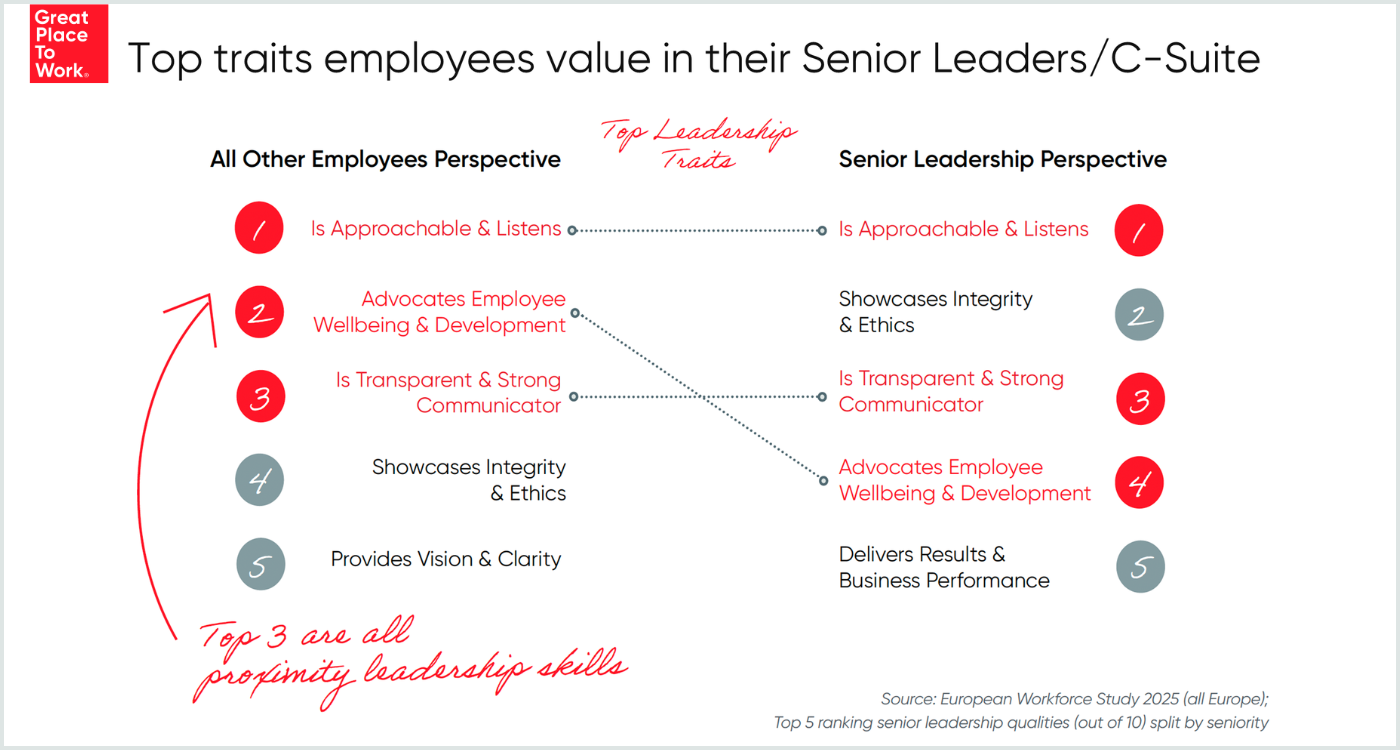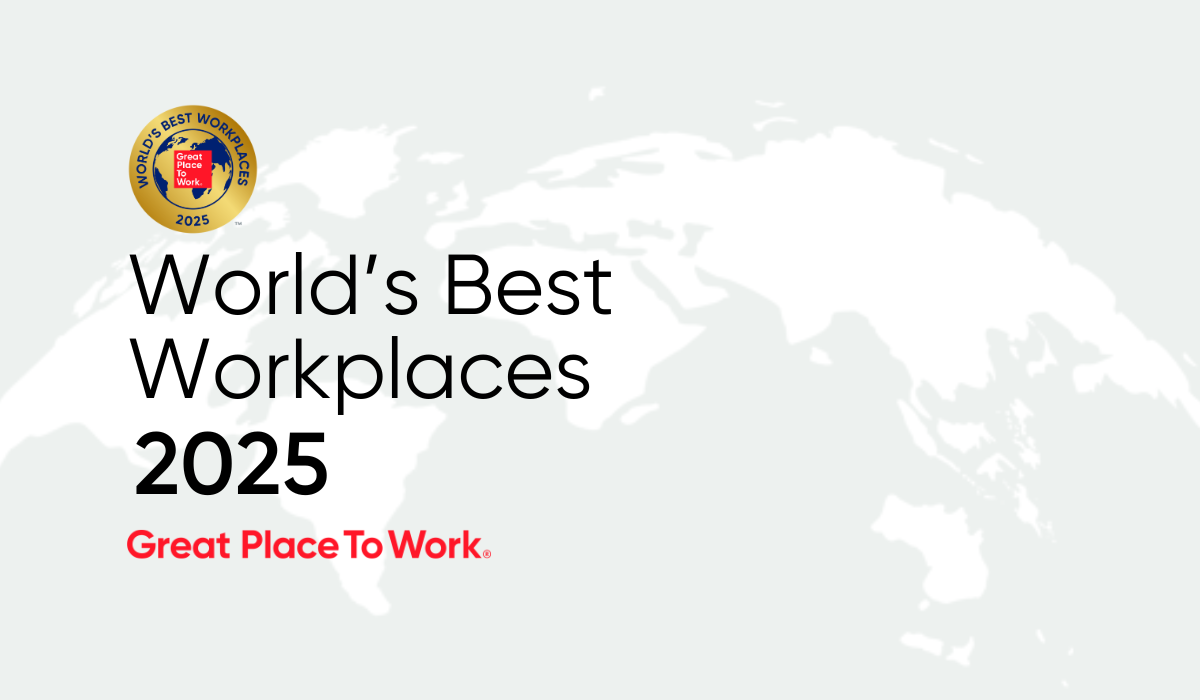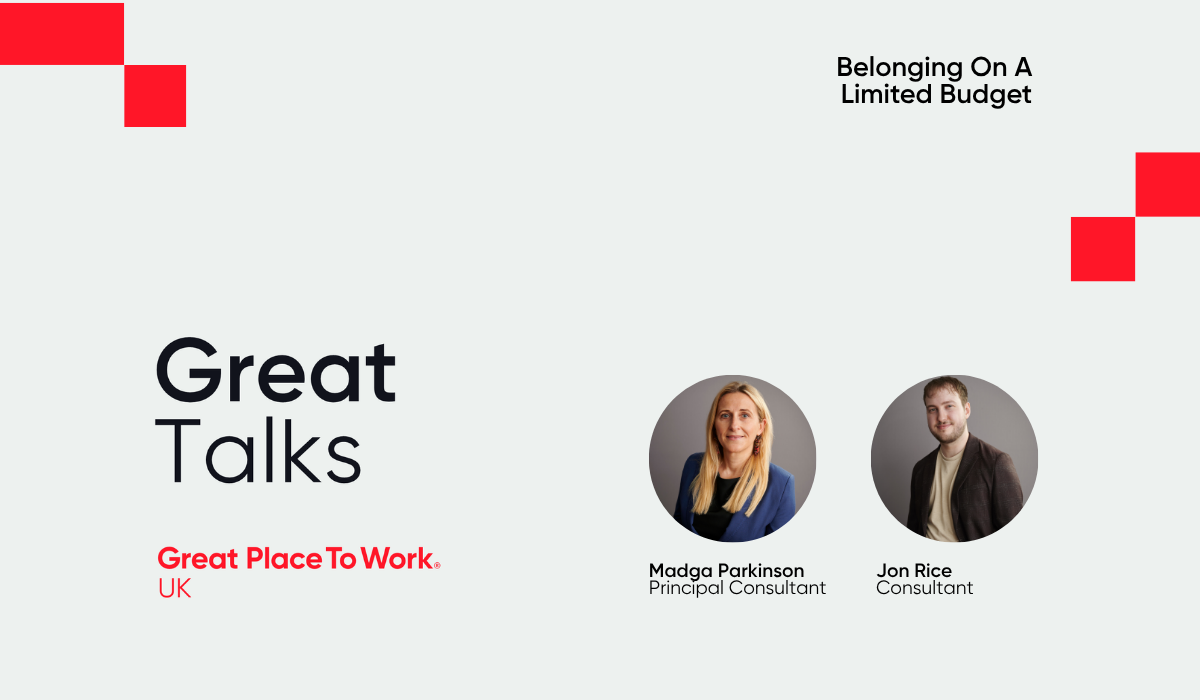Dr Petrina Carmody, Chief Change Officer at Great Place To Work, shared key industry insights from the retail, hospitality and leisure sector at an intimate roundtables event cohosted with UKG. The key takeaway of the day: the success of every strategy, practice, and programme relies on one thing: real, human connection between leaders and their people.
Undeterred by the chilly spring weather, leaders from retail, hospitality and leisure joined us for the second Great Culture Collective in-person breakfast event hosted for this sector, this year at the London Mariott Hotel County Hall.
Below, we round up some of the key insights and discussion points shared by our hosts and guests on the day:
The Trust Reservoir
Robert Levering, Co-founder of Great Place to Work®, introduced the concept of the Trust Reservoir as a metaphor to describe the accumulated emotional and relational capital built over time through consistent, respectful, and transparent interactions between leaders and their teams. It acts like a bank account of goodwill: when leaders behave with integrity, communicate openly, and show care for their people, they make 'deposits' into the reservoir. Conversely, when they break promises, act unfairly, or use every interaction to build their own image rather than building trust, they make 'withdrawals.'
For Levering, “the constant replenishing of the trust reservoir is the single most distinguishing characteristic of great workplaces."
Especially in times of crisis or struggle (such as when organisations experience significant restructuring or redundancies) leaders with a full reservoir can draw on that goodwill to maintain employee morale and engagement. In turn, employees are more likely to give their employer the benefit of the doubt when trust has been consistently cultivated over time.

Amplifying the employee experience is essential for driving business results
According to both our own studies and UKG research, organisations who invest in creating a high-trust culture and great employee experience outperform those that don't.
To do this, retail, hospitality and leisure employers need to understand what truly matters to their people, using credible data from employee surveys, focus groups, and other meaningful interactions with individuals and teams to ensure that policies and programmes established are meeting the varying needs of everyone – from the office to the frontline.
Managers, in particular, have a major impact on the employee experience and individuals' wellbeing at work. Companies who empower managers to move towards adopting a coaching style of leadership (as opposed to the traditional manager style) will be ahead of the curve as job roles and environments continue to become more digital and AI-enabled, bringing rapid change more frequently than ever before.
The Best Workplaces are known for investing in upskilling their leaders as much as their wider workforce – ensuring that learning and development is embedded in their workplace culture and is accessible and inclusive for all. It's one of the reasons why these top-performing organisations do so much better than the market. Over 4X better to be exact!

The power of proximity leadership
Proximity leadership is a leadership style fundamental to building high levels of trust between leaders and their teams through consistent, meaningful interactions – regardless of the working environment.
True proximity, therefore, is about quality engagement and connection, not mere physical presence. This is a crucial factor in today’s diverse workplaces. Organisations with smaller proximity gaps are able to foster higher employee satisfaction, improved retention (reducing turnover and preserving institutional knowledge and expertise); and strong advocacy, enhancing reputation and attracting talent.
Listening forums, 1-2-1 catchups, and surveys were cited by our Great Culture Collective delegates as important for hearing from ones' people. But are you always sure you're getting to the quietest person in the room? It's essential for managers to be mindful of this; to identify individuals who typically refrain from contributing in open forums, as well as those employees who may work night shifts or on weekends where there isn't as much opportunity for dialogue with leaders who work standard hours.
Proximate leaders adapt their approach to different scenarios, and they recognise that healthy connections are the bedrock upon
which a robust culture and the achievement of organisational goals are built.

Embracing mistakes with a no blame culture
Proximate leaders also recognise mistakes as part of doing business – choosing to be "tough on the issue, but kind on the person" as one delegate shared. They continue:
"We're all people dealing with different things in our personal lives that burden us in different ways, and that come to us at different times in our life, which we don't always show or talk about at work. Being mindful and respectful of this is so important. And ensuring our employees feel 100% that they can be open with their manager about a mistake they've made, and that this will be received with open-mindedness and kindness and a sincere wanting to help (as opposed to a fear of being punished or ridiculed) is what we try to instill within leaders in our organisation."
Something as simple as changing the terminology around mistakes, such as from 'failure' to 'learning' – living by the mantra that mistakes are acceptable, while results are critical – is something every organisation can adopt, no matter what size or sector.
"Equally, making it clear to employees the impacts of different mistakes so that they fully understand," shared another delegate. "For example, an allergy mistake in some cases can be very serious, even to the point of ending someone's life without ever meaning to. So putting those sorts of mistakes into perspective versus other instances where there's much less severity or risk."
Is there a disconnect in how your employees perceive their 'shop floor' reality vs. the 'office' reality?
Even in organisations with a great company culture, there will be some frontline employees who feel that the 'higher-ups' simply don't understand their day-to-day reality at work, or have an adequate appreciation for challenges they face on the 'shop floor' (or whatever form of frontline environment they may be in).
Having Senior leaders and C-Suite executives visit and shadow frontline teams in their physical work environment is a great start to strengthening relationships and decreasing the reality perception gaps. But it's HOW leaders approach those sorts of initiatives that will ultimately determine whether or not they are successful. That is:
- How are visits prepared for and then carried out? E.g. Have leaders reviewed employee survey comments or other qualitative data beforehand to get a sense of what people's needs and concerns were after the last visit, and have there been any improvements that could be shared during the visit to ensure employees know their voices were heard and their ideas or concerns taken seriously?
- How do your leaders show up to connect sincerely with people? E.g. Do they greet them by name; know their roles and recognise their contribution to the organisation when engaging with them?
- How authentically does your leadership team lead the business with culture rather than operations? Is there buy-in for this from everyone at the top, or are there some who may need recalibration to come on board?
| Related Read: How Savers Increases Retention Through Transformational Leadership
Facilities tops the list of key drivers of a psychologically healthy workplace in the retail and hospitality
Psychological health in the workplace affects employees’ ability to manage stress, build relationships, and perform at their best. It's an important factor in promoting overall wellbeing, productivity and performance. Interestingly, when diving into what drives retail, hospitality and leisure employees' psychological health at work, facilities came out as the number one key driver:
Great companies are heeding their peoples' calls for improving their back of house and increasing their investment in this area so that their employees feel as cared for as their customers.
As one retailer in the room shared:
"We get several requests a year asking for things to be fixed and so on. And when we looked into our engagement survey data, we realised that the stores with the the lowest engagement scores tended to also have the highest maintenance costs. This shows us that facilities matter to our people; they really make a difference."
Fixing a broken toilet or making sure employees aren't forced to eat their lunch sitting in a dimly-lit room next to a pile of paper cups (real examples!) is more than just a hygiene factor. It shows people that their employer cared enough about them to spend the extra budget to create a more dignified and fun environment.
Moreover, getting people's input on what small improvements they'd like (rather than the company going ahead with refurbishments or updates that nobody asked for) is essential. "Again, you're fostering that connection with people by involving them," says Dr Carmody. "And the way the team is treated at the back will show up in how they treat customers in the front".
People who can be themselves perform at their best
Creating a supportive work environment where everyone can express themselves is essential for building trust, engagement, and collaboration. When individuals feel accepted, they are more likely to share ideas, voice their opinions, and contribute their best efforts.
Our Great Culture Collective delegates agreed that a focus on embracing people's individuality and freedom to bring their full selves to work was critical for fostering closer connections between leaders and employees.
This could mean:
- Building empathy via providing opportunities for people to learn about things we all have biases around or perhaps simply don't know about – e.g. the three life stages of maternity, menopause and menstruation, and their impacts on working women throughout their career;
- Allowing people to have difficult days when they need to – e.g. during a new life stage (such as the menopause); or a change in one's health or wellbeing (such as receiving a diagnosis for a new condition like ADHD or bipolar, or returning to work after cancer treatment).
- Giving people autonomy in how they choose to express their identity within the parameters of the culture or policies –such as removing strict guidelines related to footwear or uniforms, or allowing employees to wear their hair in any colour or style without having to ask permission. As one delegate shared: "I was so surprised one day when a female colleague came up to me and nervously asked me if she could dye her hair. I just thought: it doesn't affect what she does, so why not? Even six years later, she still mentions it. My nonchalance about the whole thing was really important to her that she could just make that choice for herself, without needing to ask permission like she used to."
Transform your culture from the inside out. Learn about our Executive Coaching and Leadership Development offering here.













